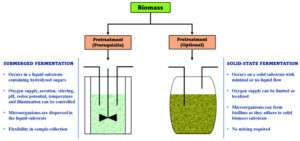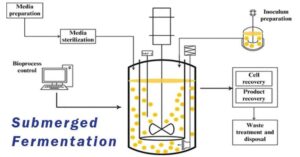Back to: MICROBIOLOGY 400 LEVEL
Welcome to class!
Hello there, brilliant mind! I hope you’re feeling energised and ready to learn something new today. You’ve come such a long way already, and now, it’s time to grow even deeper in your understanding of industrial microbiology. Today’s topic is one you’ll often hear in both Nigerian food processing industries and global biotechnology labs—Types of Fermentation: Solid-State and Submerged. Let’s break it down together in a way that feels close to home.
Types Of Fermentation: Solid-state, Submerged
What is Fermentation?
Fermentation is a metabolic process where microorganisms like bacteria or fungi break down sugars to produce useful products such as alcohol, acids, gases, or enzymes. You’ve seen fermentation at work if you’ve watched palm wine bubble, ogi (pap) ferment, or even bread rise. It’s also key in producing antibiotics, citric acid, and even animal feed supplements. In industrial microbiology, we use specific types of fermentation techniques depending on the type of microorganism and the product we want to make.

Now, there are two major types of fermentation based on how the microorganisms are cultured: Solid-State Fermentation (SSF) and Submerged Fermentation (SmF).
Solid-State Fermentation (SSF)
In SSF, microorganisms grow on solid materials without free-flowing water, although the solid material still contains some moisture. It mimics natural microbial habitats like soil or compost heaps where fungi and bacteria grow on moist solids.
Examples of solids used in SSF include agricultural by-products like cassava peels, maize bran, rice husks, and yam peels—resources we’re very familiar with in Nigeria. Fungi such as Aspergillus and Penicillium thrive in these conditions.
SSF is especially good for producing:
Enzymes (e.g., amylase, cellulase)
Organic acids
Traditional fermented foods (like ogiri, iru, and soy-based foods)
Advantages of SSF:
Low cost and uses waste materials
Less water needed
More concentrated product
Eco-friendly and culturally relevant in African settings
Limitations:
Not suitable for microbes that need lots of water
Harder to control temperature and pH
Extraction of products is more difficult
Submerged Fermentation (SmF)
This method involves growing microorganisms in a liquid nutrient medium where everything is fully submerged in water. It’s the most widely used fermentation method in modern industries.
Bacteria, yeast, and some fungi are commonly used in SmF, especially for producing:
Antibiotics (like penicillin)
Ethanol (for fuel and beverages)
Citric acid
Single-cell proteins
Think of SmF like how you cook ogi in plenty of water—it’s uniform, easy to stir, and easy to monitor. In industries, SmF takes place in large fermenters or bioreactors with strict control over aeration, temperature, and pH.
Advantages of SmF:
Easy to monitor and control
Product extraction is simpler
Ideal for mass production
Suitable for a wide variety of microbes
Limitations:
Requires more water and energy
More expensive to run

Diluted products may need concentration
Comparing SSF and SmF in a Nigerian Context
Imagine you’re producing amylase enzymes. If you want to do it cheaply using cassava waste in a small-scale lab, SSF might be your best bet. But if you’re running a large-scale factory producing ethanol, you’ll likely need SmF because of the strict control and higher output.
Summary
- Fermentation is the microbial breakdown of substances to produce useful products.
- Solid-State Fermentation uses solid moist materials without free-flowing water and is suitable for fungi and enzyme production.
- Submerged Fermentation uses liquid media and is ideal for large-scale production of antibiotics, alcohol, and acids.
- SSF is cheaper and eco-friendly but harder to control.
- SmF offers higher control and scale but at a higher cost and dilution of products.
Evaluation
- Define solid-state fermentation and give two examples of products obtained through it.
- List two major differences between SSF and SmF.
- Which fermentation method is better suited for industrial antibiotic production and why?
Your mind is stretching, and your confidence is growing with every lesson. Keep pushing your limits—you’re preparing for a future filled with discovery and purpose. Afrilearn is proud to be with you every step of the way. See you in the next lesson!
